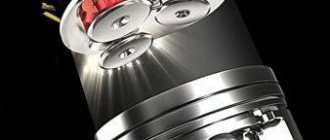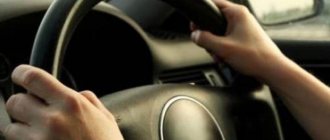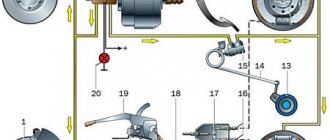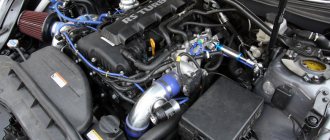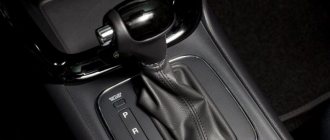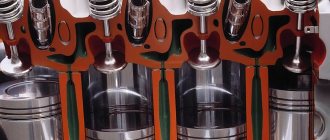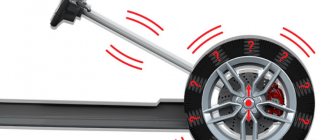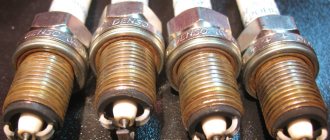VAZ 2110 – steering wheel vibrations
Car owners often face the problem of play and wobble in the steering wheel. Thus, vibration on the steering wheel of a VAZ 2110 is a fairly common phenomenon, observed more often at a speed of 90 km/h. The shaking increases more and more when driving exceeds 100 km/h, regardless of the road surface. Let's try to figure out in this article why vibrations occur on the steering wheel of the VAZ 2110?
Diagnostics and standard causes of vibrations
VAZ 2110 vibration on the steering wheel
There may be several reasons why vibrations are observed on the steering wheel of a VAZ 2110 car. In many cases, a superficial diagnosis will not provide accurate answers, and only a competent, thorough examination will help determine an accurate diagnosis.
Brake pads
As a rule, new motorists who understand little about cars naively believe that shaking and vibration are the result of worn brake pads. Having installed new brake pads, motorists begin to understand that the reasons lie much deeper. Although, if this “disease” has not gone too far, then changing the pads also helps, but for a while. And for the most part, replacing pads with new ones is a waste of time and effort.
Discs
As for the so-called “garage” specialists, they will all say the same thing - vibrations are associated with brake discs that need to be replaced with new ones. And it is imperative to install imported brake discs, since domestic ones do not cope well with their function. What's true is true. The runout of domestic brake discs installed on a car is much greater than even that of old discs installed on an assembly line. In addition, the metal of our discs is often “raw,” so to speak, that is, it is easily affected by the brake pads and wears off.
Note. Installing new brake discs does not completely guarantee that vibrations will disappear. The fact is that the reason may lie even deeper, and changing disks will only give half the effect.
Grooving brake discs
Grooving brake discs
Usually, when a car runs more than 50 thousand km, complaints about steering wheel shaking increase. The standard diagnostic option in service centers is as follows:
- The chassis of the car is carefully checked;
- The vehicle controls are subject to diagnostics;
- The left steering tip is often replaced;
- Wheels are being balanced;
- Brake discs are either replaced with new ones or sharpened.
The question arises: why buy new brake discs, especially ventilated ones (they are not cheap), if you can simply grind them, which gives excellent results.
Attention! It is noteworthy that sharpening brake discs is not so easy. This requires the skills of a highly qualified turner, who can identify by eye the excess part of the working surfaces, which he can successfully grind off. After this, the surfaces may remain rough, but there is no need to worry about this.
Attention! The minimum permissible thickness of a ventilated disc for a VAZ 2110 is 17.8 mm, and a non-ventilated one is 10.8 mm.
Non-standard reasons
It’s interesting, but it also happens that after sharpening and installing the discs, the vibrations on the steering wheel do not disappear. In this case, an unconventional method can help - turning the hub itself on a lathe, which reduces runout.
Algorithm for grooving the hub
- A special device is attached rigidly and at the desired angle (necessarily strictly perpendicular to the plane of rotation);
- Powerful supports are placed under the car;
- The jack is removed, and the brake caliper is tied firmly to the shock absorber strut.
Note. You need to tie the brake caliper with wire and away from the lathe.
- We start the engine;
- We turn on fourth gear;
- We connect the “machine”.
Note. The chips should be thinly wound around the cutter. After one full pass, the remaining portion will be visibly visible on the hub. After the next few visits, this very “bald patch” will completely disappear.
- The hub is ground to zero.
The grenade fell apart
On a VAZ 2110, the causes of vibration in the steering wheel may be associated with a grenade, although some would-be masters deny this. Features of steering wheel vibration when a grenade is scattered:
- When accelerating, vibrations are clearly felt;
- You feel them and disappear when you coast;
- In the early stages, steering wheel vibration can be felt at speeds of 60-80 km/h;
- At low speeds vibrations are not felt;
- The car may run off the road in the later stages of this disease, especially at speeds above 100 km/h;
- In addition to the vibrations, you also feel a terrible knocking sound, and when you release the gas pedal, the vibration immediately disappears;
- Vibrations can clearly increase in proportion to the number of people in the cabin (the more people there are, the stronger the vibration);
- A strong frontal wind can also cause an increase in vibrations.
If you observe the above symptoms, you need to inspect the grenade. It is noteworthy that a CV joint defect may not be immediately noticed. You'll have to tinker a little, take the shafts with grenades in your hands and twist them, changing the angle.
Wheel balancing is the most common cause of vibration in the steering wheel.
Steering wheel VAZ 2110
Discs
The most common cause of steering wheel wobble on the “ten” and all VAZ cars is brake discs. They may even be new, but from the factory have deviations in geometry, hence the problems. It is almost impossible to check this visually when purchasing; you need to either look for branded spare parts, or try different batches, try to find disks from older cars.
If the brake discs are crooked, it can hit not only the steering wheel, but also the brake pedal. But with severe wear, vibration usually goes mainly to the steering wheel. Naturally, when replacing discs, you should immediately change the pads and check the calipers; there should be no play or varying degrees of fit.
In principle, approximately 85% of runout cases occur in the discs and brake mechanism. It’s also worth checking all the caliper fastening units, maybe a bolt has been cut off somewhere or has become unscrewed.
Wheels and chassis
The VAZ-2110 and the entire family, due to front-wheel drive, experience increased load on the front wheels. It is imperative to do balancing, as well as check the condition of the nuts, hub, and the chassis as a whole.
Quite often the wheel itself hits when braking. And not because of balancing, but because of broken bolts and holes. You can try to remove the wheel, move it one bolt forward in a circle, and check the result. Some people wrap one turn of electrical tape, this helps at least diagnose the problem. If the problem disappears for a short time, then the problem is with the disks and fasteners.
Steering rods, steering knuckles, ball joints, levers - all this needs to be tugged on the lift to check for play. Again, when driving, you should carefully listen to the operation of the suspension on turns or bumps. After the trip, check the same hubs by hand for heating.
In principle, the VAZ-2110 is such a car that if there is no steering wheel beat at speeds up to 90 km/h, then this is normal. Driving it at a higher speed is in any case dangerous, even if the chassis is in perfect condition - the issue here is the quality of the parts and the generally weak strength of the car.
If the steering wheel vibrates at a speed of 100-120 km/h, this does not mean that it is necessary to immediately balance the wheels on the car. Causes vary, although this is the most common reason. Most car owners believe that steering wheel wobble and car vibration occur due to wheel imbalance, but there may be other reasons.
The problem may arise that the steering wheel, as well as the car body, is the most popular and unpleasant problem. In addition, it most often appears unnoticed until our patience is exhausted by the fact that the steering wheel is already hitting too hard, and it affects the entire car. However, drivers quickly get used to this and do not rush to a car service or tire shop to resolve the issue.
But, usually at this moment people wonder what the vibration of the car means and why the steering wheel shakes. There are many reasons why your car and steering wheel vibrate. This problem can be sorted out without significant financial costs. Once the cause of the vibration is found, you may need to pay to have it repaired and solve the vibration problem. However, you should know that in the future this procedure will save us money, since without carrying out repairs, some suspension or steering components may fail.
Ways to solve the problem
Whatever the reasons for the steering wheel beating, it is necessary to carry out high-quality diagnostics and eliminate the problems. This will make it possible to avoid expensive repairs, and most importantly, prevent accidents!
If the steering wheel shakes at low speed, proceed as follows:
- check the cleanliness of the wheel rims;
- check the balancing and fastening of bolts on the wheels;
- test discs for deformation;
- check the quality of rubber;
- diagnose the suspension;
- examine brake discs and drums;
- check the engine mounting;
- try the quality of the drive shaft.
Wheel rims are easier and faster to clean at a car wash. A stream of water will remove accumulated dirt. Hit the disc with some object, reducing the amplitude of vibrations of the steering wheel, in order to safely drive to the car wash or service station.
Have your balancing done at a tire shop. Balance all 4 wheels, especially if the steering wheel shakes at low speeds. At the same time, eliminate the deformation of the wheel rims and give them their initial shape on a straightening machine.
Replace defective tires. It will not be possible to restore it - you will have to buy new tires and mount them according to the canons of proper balancing.
Steering wheel wobble at speed due to a faulty suspension or steering mechanism is “treated” by disassembling the chassis, inspecting the parts and fixing the problem. More often than others, grenades (CV joints), rubber-metal joints, and steering bushings break.
The beating that occurs during braking can be eliminated at a service station. The machine grinds and restores the surface of the brake discs if the degree of wear is low.
It is better not to fix steering wheel wobble at speed yourself. Only car services will accurately determine the cause of the breakdown and eliminate it. Most workshops work with specific brands of cars; they have a better understanding of the specifics of the models, know the characteristic “sores” and are able to quickly recognize them.
Snow and mud affect wheel balance
One of the most obvious reasons for vibration of the steering wheel at high speed, as well as the entire car, is the clogging of the wheel rims with snow or mud. In this case, the beating is created for some time, and may disappear after accelerating the car, and not occur again, or after a short period of travel. It is quite easy to detect the presence of snow on alloy wheels. The situation is more complicated with steel wheels. They usually have small holes for ventilation, and may also have decorative caps installed. Dirt most often accumulates on the inside of the wheel.
Engine mount wear
Another reason for the steering wheel beating at a speed of 100 km/h is wear of the engine mount. The engine mount may not compensate for vibration, especially when the car accelerates, which leads to noticeable wobbling of the steering wheel at high speed. You can identify such malfunctions by inspecting the engine compartment, where you will see that the engine seems to have fallen on one side. In such a case, repairs involve replacing worn out engine mounts, which completely solves problems with steering wheel wobble.
The steering wheel only vibrates at high speeds
Typically, neither wheel rims nor tires have a completely ideal shape or surface. The mass of different elements of the wheels differs, then during the rotation of the wheel the heaviest place attracts the middle of the wheel, which is a centrifugal force, and this means that at high rotation speeds this effect will be transmitted along the chain to the steering wheel in the form of vibration.
Therefore, wheel balancing must be done in a timely manner, as well as when replacing wheels or tires on a car. The essence of balancing is to equalize the weight of the wheel with special weights that are fixed to the disk.
Driving with wheels that are out of balance for a long time can cause a lot of wear in some areas of the tires, which will create even more vibration. Also, this problem contributes to a lot of wear on the suspension elements, namely the wheel bearing.
The main causes of imbalance are slight vibration at high speeds, in passenger cars when driving at a speed of at least 60 km per hour. You should inspect the car's wheels. If the discs do not have any damage, you have not recently driven your car into large holes, the tires are not too worn out, but vibration is felt only on the steering wheel, or when the car accelerates, first on the steering wheel, and then the whole car begins to shake, then most often The problem is detected in the imbalance of the wheels.
Many people think that if the steering wheel shakes, then only the front wheels need to be balanced. This is a false statement; all wheels must be balanced. For passenger cars, balancing will cost slightly less than for SUVs or crossovers. Typically, the cost of this work depends on the size of the wheels and the type of disk: cast or stamped.
Damaged wheels or tires cause vibration
Most often, the cause of vibration is the curvature of the wheels, which is simply determined by any tire shop specialist when rotating the wheel on a special stand. The master should inform you about this. However, it is recommended to be present during the balancing process and make sure that the wheel is correctly diagnosed. If, while rotating the wheel, observing one point on the edge of the tire, it is clear that the wheel is jumping, then it is necessary to find out the reason for this. It is necessary to determine whether the rubber jumps together with the entire wheel, or whether the disk rotates without beating. If the wheel jumps together with the disc, then the cause is the disc, and if not, then the cause is the tires.
Usually the wheel is bent due to a damaged disk when falling into a deep hole in the spring, when the holes are hidden by water. You can find out the curvature of the disks and inspect it for damage with your own hands, without removing the wheels from the car. The inner side of the disc is more susceptible to damage. Therefore, it is unlikely that you will be able to see the damage there yourself; it is better to go to a tire repair shop. Stamped steel wheels are more susceptible to damage than cast models.
But in addition to dents, the disc can be crooked during manufacturing. At the same time, when checking it on a balancing stand, it will rotate smoothly, but an imbalance will be observed on the machine. This is possible because the wheel is fixed on the balancing stand along the central hole of the hub, and on the car the wheel is mounted on other holes for nuts or bolts. It often happens that the holes do not allow the wheel to be secured exactly in the center. Also, the disc may be deformed, which usually happens with cheap steel or alloy wheels.
Wheel bolts are not tightened
This is also an easily solved problem, and also a quickly identified cause of vibration in the steering wheel and car. The fastening nuts and bolts may become loose, or the tire shop forgot to tighten them. This is the most dangerous reason. If it is not detected in time, then it will all end in an emergency situation on the road, both for the driver and for the people around him.
In this case, repairs may turn out to be expensive; if the cause is not immediately detected, then you will need to change the discs or brake disc or hub. Otherwise, the wheel will wear out on weak bolts, which will lead to serious problems and damage to the bolts, as well as the holes in the wheel.
The causes of vibration for these symptoms are similar to those if the vibration were from damaged tires or wheels, with the difference that the runout can begin at low speed, even at the beginning of movement, and the vibration can appear with an untracked cyclicity, and appear at different speeds . To solve the problem, you need to tighten all the nuts and bolts on the wheels.
What harm can vibration in a car cause?
It is quite clear that the amount of damage depends greatly on which particular unit caused the shaking of the car. If the engine mount is the culprit, for example, then a constant increase in shaking can cause a number of problems in the power unit. Increased vibration of exhaust system elements will lead to destruction of mechanical connections in this system and premature failure of a number of components.
There are also general consequences of constant strong vibration:
- increased wear of interior parts that do not like vibration, since hard plastic will actively rub against other elements and wear out;
- failure of seals that do not tolerate vibration loads, this is fraught with leakage of some technical fluids and depressurization of components;
- loss of tightness of antifreeze circulation systems; clamps may become loose, causing coolant to drip into the connections;
- maximum discomfort of traveling in a car, which can cause fatigue on long trips and decreased concentration;
- a gradual increase in vibration resonance can make it completely impossible to drive a car at a certain speed.
You should not delay calling for service if you notice vibrations and resonance in your car. Perhaps you just need to change the rubber muffler hangers to get everything back to normal. You don't necessarily have to expect expensive and complicated repairs. So it is very important to contact specialists in time for diagnostics in order to reduce the discomfort of operating the machine and significantly reduce the cost of repair work.
For useful tips on some possible causes of shaking, watch the video:
Faulty or worn steering or suspension components
Significantly worn suspension elements also affect the vehicle's contact with the road surface. This depends on the fact that if the suspension elements create play, this will lead to an imbalance during rotation if the wheels were not balanced. But this also causes other problems that are not related to wheel imbalance and high wear.
But you need to know that the play of the suspension elements is not capable of directly affecting and creating vibration of the car or steering wheel. In this case, a broken suspension part will only contribute to the occurrence of vibration coming from the wheel. Moreover, if we talk about problems due to a faulty suspension, we assume that there are faults in the suspension, but the main reason is still the wheels.
This means that failures in the steering and suspension are the causes of steering wheel wobble, and they should be in last place, and the causes of vibration due to this depend on the main problem.
Case from practice
A similar phenomenon began to be noticed by the owner of a Volkswagen Golf; extraneous vibrations appeared in the steering mechanism when the car was moving around 70 km/h
. If the speed was insignificant, vibrations disappeared; after accelerating the car over 100 km/h, they were also not observed.
Taking into account the quality of our roads (which is poor), and plus the vibrations and beatings that a faulty steering mechanism creates, driving such a car turned into torture. The steering wheel just almost jumped out of my hands.
Naturally, the most effective and simplest way is to take the car to a service station.
. But it’s good if you have a familiar auto mechanic who will do everything efficiently. And if not? Then few people will give you a guarantee that the car will be repaired quickly, and the money that will be taken from you will be comparable to repairs.
Yes, such a problem occurs quite often; auto mechanics constantly make money from such troubles, increasing the cost of repairs. They may also impose costs on you for unnecessary manipulations, for example, replacing the entire steering mechanism, because few people want to dig around and look for the real causes of the malfunction. To prevent this from happening, any car owner should at least roughly know the reasons for this behavior of the steering wheel.
Violation of wheel alignment geometry
Directly dependent on incorrectly set wheel geometry, vibration can occur only during acceleration or in a certain speed range. You can find out if the toe-in and camber are installed incorrectly quite quickly - make a visual inspection of the tires and see how they wear out. If they have large uneven wear, this indicates a violation of the wheel alignment angles.
If the tires are worn only on the outside, or only on the inside, then this indicates a violation of the geometry. This issue can be resolved by adjusting the installation angles. Only in this case, vibration of the steering wheel when driving 100-120 km per hour will quickly disappear.
However, it may happen that the toe and camber are adjusted, but the fault does not disappear. The installation angles are adjusted correctly. But the car owner decided not to replace the tires with new ones, since they were not too worn out yet and could be used. In this case, you should drive at low speeds so that the tires wear evenly, and the problem will disappear.
conclusions
Knowing these points, the owner can independently identify the reasons why the steering wheel of his VAZ-2112 car occurs when braking or at speed. If you cannot identify the reasons yourself, you should contact a service station. Operating a car with such a malfunction is dangerous!
After using the car for a long time, many drivers stop noticing the steering wheel vibrations that occur. But sometimes such beating is a consequence of vehicle malfunctions, and if they are not corrected in a timely manner, driving safety can be greatly reduced.
